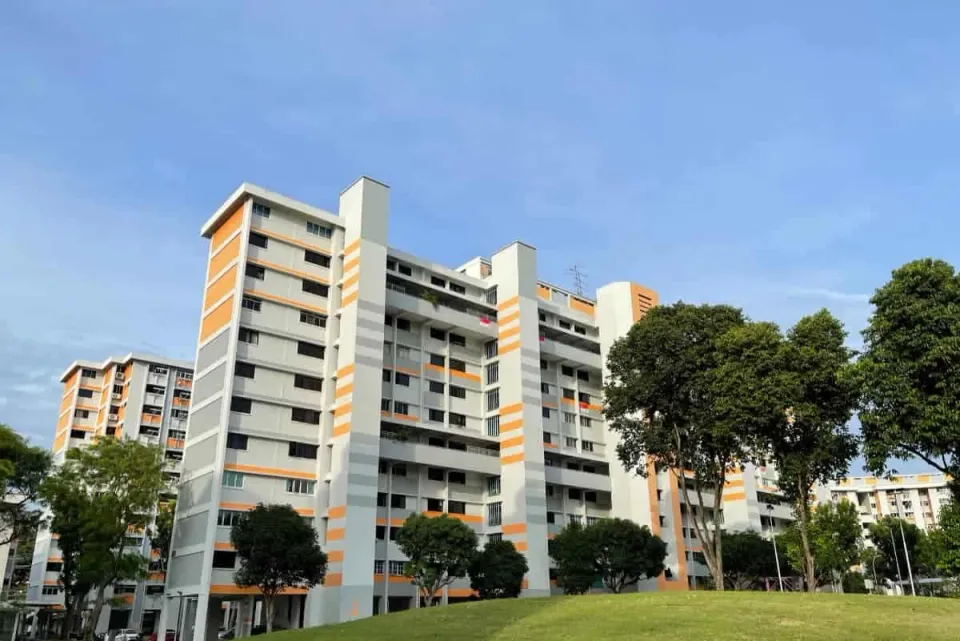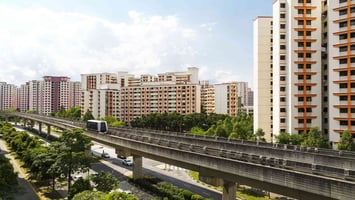Singapore HDB Buyers: Cash Upfront or Max Loan—What Fits Your Strategy?
TLDR;
- Paying a larger down payment for your HDB flat can lower monthly payments and total interest but reduces liquidity.
- Maximising your loan preserves cash for investments but increases long-term costs and financial risk.
- The best choice depends on income stability, risk tolerance, and financial goals.
Buying an HDB flat is a significant step, and deciding between paying more upfront or taking the maximum loan can be overwhelming.
This decision impacts your monthly budget, long-term costs, and financial flexibility. In this article, we’ll break it down into simple terms to help you decide what fits your strategy,
Financing Options Overview
Let’s say you have two main financing options: the HDB Loan and bank loans. The HDB Loan offers a fixed interest rate of 2.6% (as of early 2025) and allows up to 80% LTV (Loan-to-Value).
This means you can borrow up to 80% of the flat’s value. Bank loans typically have floating rates and a 75% LTV cap, requiring at least 5% cash down payment.
For most, the HDB Loan is easier to manage due to its stability.
Cash Upfront vs. Max Loan: Quick Comparison
Here’s a snapshot of how these strategies play out for a S$600,000 flat with an HDB Loan at 2.6% for 25 years:


| Aspect | Cash Upfront (40% down) | Max Loan (20% down) |
|---|---|---|
| Down Payment | S$240,000 | S$120,000 |
| Loan Amount | S$360,000 | S$480,000 |
| Monthly Payment | ~S$1,733 | ~S$2,313 |
| Total Interest Paid | ~S$160,000 | ~S$214,000 |
| Liquidity Preserved | Less | More |
| Investment Opportunity | Less cash to invest | More cash to invest |
Paying more upfront saves interest and lowers monthly payments but ties up more money. Maximising the loan keeps cash free for investments but costs more over time.
Factors to Consider
Your choice depends on your situation:
- Income Stability: Can you handle higher monthly payments if you max the loan?
- Risk Tolerance: Comfortable investing the saved cash, or prefer the safety of lower debt?
- Goals: Planning for family expenses might mean keeping liquidity, while saving on interest suits long-term stability.
Detailed Analysis:
Understanding HDB Financing Options
Before diving into the strategies, let’s clarify the financing options available for HDB buyers. There are two primary ways to finance your HDB purchase:
- HDB Loan (Concessionary Loan):
- Interest Rate: Fixed at 2.6% per annum (as of early 2025), pegged to the CPF Ordinary Account (OA) interest rate plus 0.1%. This rate is adjusted quarterly in line with CPF interest rate revisions, providing stability.
- Loan-to-Value (LTV) Ratio: Up to 80% of the flat’s purchase price or value, whichever is lower, effective from September 30, 2022.
- Down Payment: Minimum 20%, which can be paid entirely from CPF OA, cash, or a combination.
- Loan Tenure: Up to 25 years or until the borrower reaches 65 years old, whichever is earlier.
- Bank Loan:
- Interest Rate: Typically floating, pegged to benchmarks like SORA or SIBOR, or fixed for a certain period (e.g., 1-3 years).
- LTV Ratio: Up to 75% for first-time buyers with no existing home loans.
- Down Payment: Minimum 25%, with at least 5% in cash and the remaining 20% from CPF OA or cash.
- Loan Tenure: Up to 30 years or until the borrower reaches 75 years old, subject to bank policies.
For most HDB buyers, especially first-timers, the HDB Loan is the go-to choice due to its fixed interest rate and higher LTV ratio.
The Cash Upfront Strategy: Pros and Cons
Let’s start with the cash upfront strategy, where you pay a larger down payment and take a smaller loan. This means using more of your savings or CPF OA to reduce the loan amount, aiming for lower monthly payments and less interest over time.
Pros:
- Lower Monthly Payments: With a smaller loan, your monthly mortgage payments will be lower, easing your cash flow. For example, on a S$600,000 flat with a S$360,000 loan at 2.6% for 25 years, the monthly payment is approximately S$1,733, compared to S$2,313 for a S$480,000 loan.
- Less Total Interest: Since you’re borrowing less, you’ll pay less interest over the life of the loan. In the example, a S$360,000 loan results in about S$160,000 in total interest, while a S$480,000 loan incurs around S$214,000, saving you roughly S$54,000.
- Faster Equity Buildup: Paying more upfront means you own a larger share of the property from the start.
- Potential for Early Repayment: With lower monthly commitments, you might be able to pay off the loan faster.
Cons:
- High Upfront Cost: You need substantial savings or CPF balances to cover a large down payment.
- Opportunity Cost: The money used for the down payment could have been invested elsewhere, potentially earning higher returns.
- Less Liquidity: Having less cash on hand can be risky if unexpected expenses arise.
The Max Loan Strategy: Pros and Cons
Now, let’s look at the max loan strategy, where you take the largest possible loan and minimize your down payment. This means borrowing up to the 80% LTV limit for HDB loans, keeping more cash in hand.
Pros:
- Lower Initial Outlay: You need less money upfront, helpful if your savings are limited.
- Preserved Liquidity: Keeping more cash means you have more flexibility for investments, emergencies, or other expenses.
- Investment Opportunities: You can invest the saved cash in other assets that might yield higher returns than the loan interest rate.
- Easier Qualification: If you qualify for the maximum loan, it might be easier to buy a more expensive flat.
Cons:
- Higher Monthly Payments: A larger loan means higher monthly mortgage payments.
- More Total Interest: You’ll pay more interest over the life of the loan.
- Slower Equity Buildup: Since you’re borrowing more, your ownership stake in the property grows more slowly.
- Greater Financial Risk: Higher monthly commitments can be stressful if your income is unstable or if interest rates rise.
Factors to Consider When Choosing a Strategy
Deciding between cash upfront and max loan isn’t just about numbers; it’s about your personal financial situation and goals. Here are some key factors to consider:
| Consideration | Key Details |
|---|---|
| Financial Goals and Risk Tolerance | - If you’re risk-averse and prefer stability, paying more upfront might be better. - If you’re comfortable with risk and believe in higher investment returns, max loan could be appealing. |
| Income Stability | - If your income is steady and you can afford higher monthly payments, a max loan might work. - If there’s uncertainty in your income, lower monthly payments from a larger down payment are safer. |
| Investment Opportunities | - Do you have access to investments that can outperform the loan interest rate (2.6%)? For example, equity markets or REITs might offer higher returns, but remember that investments carry risk. |
| Emergency Fund | - Ensure you have sufficient savings for emergencies before tying up too much money in the down payment. |
| Age and Loan Tenure | - Younger buyers might have longer to pay off the loan and can afford higher payments. - Older buyers might prefer to pay off the loan faster to reduce long-term commitments. |
| Family Planning | - Upcoming expenses like children’s education might require more liquidity. - If you’re settled and want to minimize debt, paying more upfront aligns with long-term financial peace. |
| Interest Rate Environment | - With fixed HDB loan rates, you don’t have to worry about rate increases, a significant advantage over bank loans with floating rates. |
Calculating the Financial Impact
Let’s look at a concrete example to see how these strategies play out, using a $600,000 HDB flat with an HDB Loan at 2.6% fixed for 25 years.
Max Loan Strategy:
- Down Payment: S$120,000 (20%)
- Loan Amount: S$480,000
- Monthly Payment: Approximately S$2,313
- Total Interest Paid: Approximately s$214,000
Cash Upfront Strategy (40% down payment):
- Down Payment: S$240,000 (40%)
- Loan Amount: S$360,000
- Monthly Payment: Approximately S$1,733
- Total Interest Paid: Approximately S$160,000
By paying an additional S$120,000 upfront, you save about S$54,000 in interest over 25 years and reduce your monthly payments by S$580.
However, that S$120,000 could be invested elsewhere. If invested at 5% annually, it would grow to around S$406,000 in 25 years, far exceeding the S$54,000 interest saved.
But, this assumes consistent 5% returns, which isn’t guaranteed and involves market risk.
Moreover, using CPF OA for the down payment means you’re giving up CPF interest (2.5%).
However, since it’s less than the loan rate (2.6%), using CPF for a down payment is still beneficial, as you save on the higher loan interest rate.

Choosing between cash upfront and max loan for your HDB purchase is a personal decision. It all depends on your financial situation, goals, and risk tolerance.
There’s no one-size-fits-all answer. Nevertheless, by understanding the pros and cons and considering your specific circumstances, you can make a choice that aligns with your strategy.
Assess your financial health, plan for the long term, and perhaps consult with a financial advisor to ensure you’re making the best decision for your future.
Let us know what you think about this topic, and what do you want to hear next.
You can now be our community contributor and make a pitch to have your favourite personality be on our show.
Join our community group and drop us your insights on this topic.

-3.png?width=50&name=Square%20(2)-3.png)


:max_bytes(150000):strip_icc()/SingaporeDollar-ce1582fcbf984f0ba42f95bfc3c76196.jpg)







Let us know what you think of this post